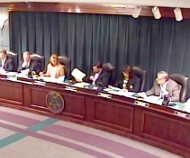Article from: www.thenewspaper.com/news/44/4480.asp
8/6/2014
California City Defies Grand Jury Over Red Light Cameras
Marysville, California refuses to make any changes to its red light camera program.
 Officials in Marysville, California do not like what they were told by the Yuba County civil grand jury about cleaning up the red light camera program. On Tuesday the city considered a response to the grand jury report that refuses to accept the panel's most important recommendations.
Officials in Marysville, California do not like what they were told by the Yuba County civil grand jury about cleaning up the red light camera program. On Tuesday the city considered a response to the grand jury report that refuses to accept the panel's most important recommendations.
In June, the grand jury investigated every claim made by the city and Redflex Traffic Systems, the Australian firm that owns and operates the cameras, and produced a final report insisting that the city use right-turn arrows to avoid trapping motorists with $479 tickets while performing a perfectly safe right turn on red (view report). The report also pointed out that accidents were not the sole criterion for deciding where to install red light cameras. The city accepted the latter finding.
"The assessment of conditions which warrant placement of a red light camera is broader than simply the analysis of collision data," the city's proposed response stated. "All of the following go into the process of determining camera locations: collision data, identifying the frequency and severity of collision data in and around the subject intersection; traffic volume... and frequency of red light violations other than those resulting in collisions for a specific approach through the subject intersection."
Violations that do not cause accidents refers to the right-hand on red citations. At Third and F, Tenth and Ramirez nearly all the photo tickets that Redflex mails go to vehicles making right-hand turns. The city outright refused to eliminate this source of citations by installing a dedicated green turning arrow, saying there was not enough room for one. The city also rejected a call to utilize engineering countermeasures, post an extra speed limit sign and increase yellow signal warning times.
"Until the body of traffic engineering opinion reaches the conclusion that longer intervals will improve compliance, the city will continue to adhere to the intervals set by Caltrans, in accordance with state law," the response stated.
Under California law, the yellow intervals are stated as minimums and can be increased at the discretion of a traffic engineer. The state's published guidance on the topic notes the benefit of longer yellows.
"Field studies demonstrated that increasing the yellow timings at several intersections with red light cameras in the city of San Diego by only 1 to 1 1/2 seconds would decrease the number of tickets issued by the cameras from about 3000 per month to less than 500," Hamid Bahadori, chairman of the California Traffic Control Devices Committee, wrote.
Marysville blamed a vendor for producing reports containing inaccurate accident figures, but it refuses to provide any additional data online.
A final version of the response is due by September 11.
 Officials in Marysville, California do not like what they were told by the Yuba County civil grand jury about cleaning up the red light camera program. On Tuesday the city considered a response to the grand jury report that refuses to accept the panel's most important recommendations.
Officials in Marysville, California do not like what they were told by the Yuba County civil grand jury about cleaning up the red light camera program. On Tuesday the city considered a response to the grand jury report that refuses to accept the panel's most important recommendations.